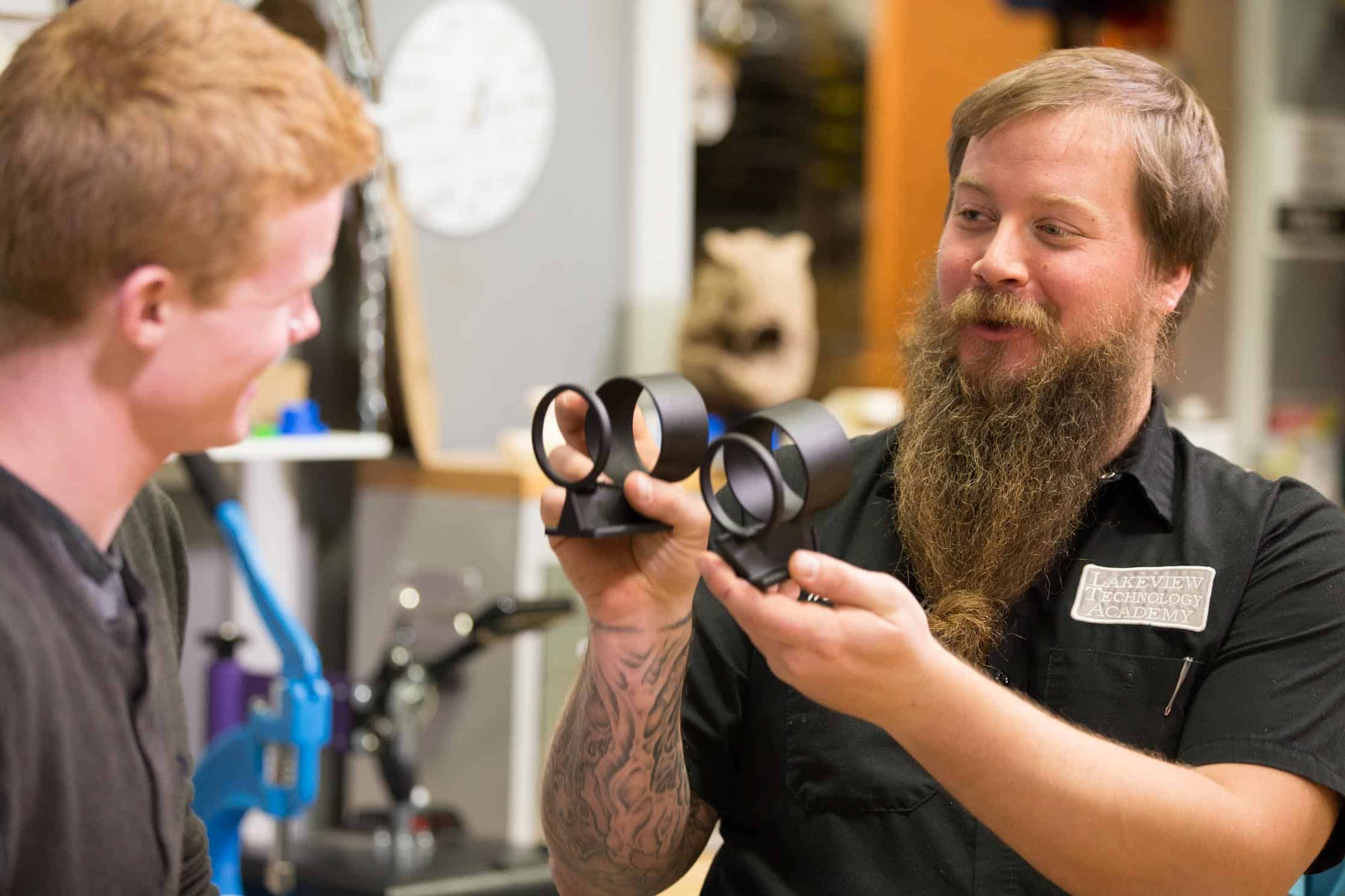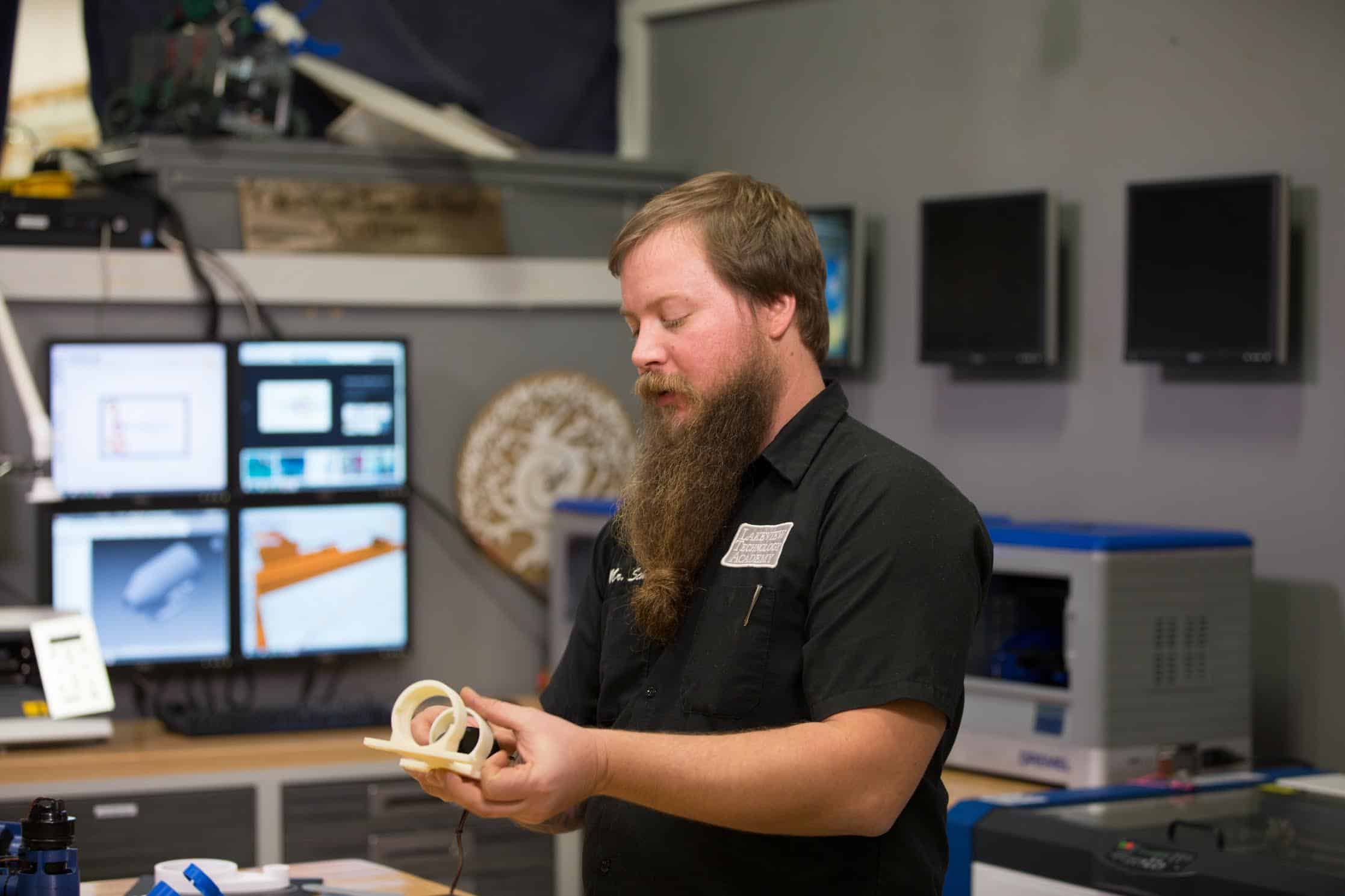Take Charge of Your Learning: Passions and Career Interests Will Follow

By Matt Schultz
“Learn by doing” is an age-old approach to education. As a technology and engineering instructor, I know that hands-on applications are necessary for students to comprehend theory. However, I’ve found learning by doing to be most rewarding as an educator because I see it transform students into passionate, independent thinkers.
One hundred percent of the content I teach has a direct application for students to put their knowledge to the test. My goal as an instructor is to provide avenues for students to challenge themselves — even when it means failing and trying again — in an effort to introduce them to areas of interest that they might not naturally gravitate toward.
When I notice a student taking an interest in a new area, I introduce them to additional courses, leadership roles, take-home tools or extra-curricular activities to encourage them to explore that interest further. Through this, I have seen some unexpected accomplishments by students who began as novices in given skill areas. Like I’ve seen with my own students, I encourage you to take advantage of these tactics I’ve outlined below to discover your own passion or explore a hidden one, which may lead you to your desired career.
Conquer Your Fear Of Inexperience
We all have felt uncertain at times when confronting challenging material or when taking on new roles. Reflecting back on my time as a student, I know that was certainly the case for me. As a teacher, I know that it’s my job to encourage students to trust in their interests in order to move beyond that sense of uncertainty and toward success in the classroom and beyond.
 To help students reach this success, I nudge them in certain directions because I often see a natural aptitude or interest. For instance, because nearly 45% of students enrolled in my classes are female, I match groups together to give female students the opportunity to lead individual groups. I’ve found this approach to build confidence within students to the point where they become the dominant voice in the classroom. While this tactic might appear unusual, I do this to encourage the sometimes unrecognized talents of my students. At first this might be a bit uncomfortable, but it has proven successful in helping students move beyond their fears.
To help students reach this success, I nudge them in certain directions because I often see a natural aptitude or interest. For instance, because nearly 45% of students enrolled in my classes are female, I match groups together to give female students the opportunity to lead individual groups. I’ve found this approach to build confidence within students to the point where they become the dominant voice in the classroom. While this tactic might appear unusual, I do this to encourage the sometimes unrecognized talents of my students. At first this might be a bit uncomfortable, but it has proven successful in helping students move beyond their fears.
Another way I help students move beyond any apprehensions they face while learning is to encourage them to explore safe, non-threatening technology in my building and design machinery course. In particular, I’ve found my female students are less intimidated when using our 3D printer, a Dremel 3D Idea Builder, as opposed to other hand-held tools, such as band saws or lathe machines. Now, I have female students who tell me they discuss their work with welding, engines, steering components, brake systems and machine metals proudly at the dinner table.
In fact, many female students in the bio-medical engineering program, who have little exposure to fabrication and engineering skills, have modified their schedules to take more technical classes and even spend eight hours after school weekly in the energy efficient vehicle club that I advise. I encourage students to welcome changes in their skill sets and interests, even when it means reworking courses or taking on more coursework.
Moving beyond your comfort zone is a great way to explore and learn while you’re still a student. Don’t let inexperience limit you! Nudge yourself in new directions. Now more than any other time in your life is the time to know no bounds.
Take The Risk In Responsibility
If you feel as if uncertainty in your career aspirations turns you away from challenges, I advise you to be open and honest with your teachers and mentors to get the experience you believe you need to learn about the things that truly interest you.
Some of the most career-driven students begin as the most reluctant to engage in classroom activities. When assigning teams for the production project in my manufacturing course, I worked with one student who had a noticeable distaste for hands-on learning, which I believe resulted from poor experiences in prior technical classes.
 I was shocked when she said she desired to be the “company manager,” the overseer of the entire course project, a role I wouldn’t have assigned to her on my own. Although I was apprehensive to assign her to the position, I trusted my gut and rewarded the student for being open about their interests by giving them an opportunity to explore it, not knowing what the result would be.
I was shocked when she said she desired to be the “company manager,” the overseer of the entire course project, a role I wouldn’t have assigned to her on my own. Although I was apprehensive to assign her to the position, I trusted my gut and rewarded the student for being open about their interests by giving them an opportunity to explore it, not knowing what the result would be.
With minimal guidance after that moment, she was an exceptional at managing day-to-day activities and sustaining motivation among the sales team. She now admits that she loved her role in the class and now intends to pursue an occupation in management and leadership upon graduation.
Talk to your teachers and mentors; tell them what your interests are and how you see yourself in your class roles. They’ll respond to it and feel encouraged that students want to take lead in their own learning.
Step Outside Your Comfort Zone While Exploring Career Possibilities
By taking the initiative to try something new in order to pursue a passion, a moment of courage can lead to a career with local companies and beyond.
Let me give you an example. To enrich experiences for students in the energy efficient vehicle club, I formed partnerships with three local companies to develop a hub adapter for a uniquely large sprocket. The students worked together to submit designs to a local design company, Formed By Design.
Once the design company selected and edited the student design, we partnered with Owens Manufacturing in Milwaukee to machine the hub adapter. While touring the facility, one senior student took particular interest in the design process. He scheduled a second private tour of the facility, which landed him a job offer immediately upon high school graduation. I now encourage students to follow his lead and not fear exploring career paths independently.
Two years later, this student was promoted to the head position of discharge machining operator, where he now visits this year’s energy efficient vehicle club every week as a student mentor. He believes his experience has come full circle because of his decision to take initiative in extra curricular activities and job shadowing opportunities during high school.
Take Time To Tinker
One freshman who had never programmed a line of code prior to my computer engineering course. He became fascinated with robotics after building his first robot. I sent him home with an open-source electronics platform so he could practice creating interactive projects. Soon enough, he was creating his own programs and eventually robots. This particular student became instrumental in initiating a project building underwater robotics in my computer engineering and robotics course. He worked alongside me to help program the robots and even built robots for the energy efficient vehicle and robotics club.
Today, the student attends a four-year university to study computer programming. He believes the courage it took to dabble in robotics has changed his career aspirations indefinitely. Even if it means working after school or hanging out with a teacher, taking time to tinker will lead you to interests and opportunities you never before knew you had.
Recognize Chances To Seize New Opportunity
Everyone’s challenge is to recognize the opportunities available to try something new. You may discover that trusting your skills and ambitions will lead you toward new career experiences. These moments are the ones that have given my students a sense of purpose in the classroom and beyond. It’s OK to be shy or even apprehensive when learning. In fact, those are natural feelings. But, don’t let those feelings deter you from moving forward, learning more and exploring who you are and what you want.
About “GenDIY”
eduInnovation and Getting Smart have partnered with The J.A. and Kathryn Albertson Family Foundation to produce a thought leadership campaign called Generation Do-It-Yourself (GenDIY)–how young people are hacking a pathway to a career they love–on The Huffington Post and GettingSmart.com. This campaign about reimagining secondary and postsecondary education and career skills will explore the new generation building a global economy and experiences that are impact driven and entrepreneurial.
For more on GenDIY:
- Leveraging the Gap Year to Solve the Worlds Most Pressing Problems
- Core Competencies to Master: Uncovering Your Leadership Potential
- Student to Creative Director: Why Learner Experience Matters
Matt Schultz is a high school technology and engineering instructor at Lakeview Technology Academy in Pleasant Prairie, WI. Follow Kenosha Unified School District on Twitter: @kusd.
Stay in-the-know with all things EdTech and innovations in learning by signing up to receive the weekly Smart Update. This post includes mentions of a Getting Smart partner. For a full list of partners, affiliate organizations and all other disclosures please see our Partner page.



carol demski
Dear Matt:
What a well written and informative article! I am so proud of your interest and dedication given to your students and how you encourage them to go above and beyond themselves and they are so excited when they succeed! You are an outstanding example of what a good teacher is and should be!
President Barrack Obama
Matt, Wonderful article! I'm sure your students are just wonderful and love learning! Keep up the good work!